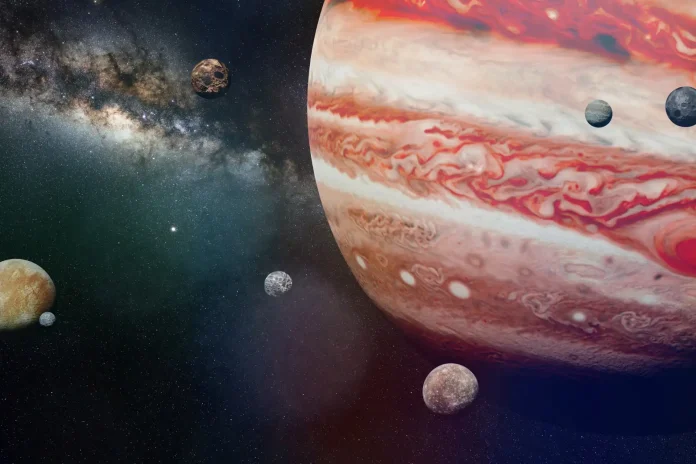Jupiter, the biggest planet in our solar system, has a captivating number of moons. Europa, Ganymede, and Callisto have captured the imagination of scientists for decades, hidden in icy mystery and hinting at the possibility of hidden oceans. To explore these secrets, the European Space Agency (ESA) embarked on an exciting mission—the JUICE mission to Jupiter’s icy moon.
Launching of JUICE Mission to Jupiter’s Moons
Launched on April 14, 2023, JUICE is on an eight-year journey toward Jupiter. This interplanetary spacecraft will utilize a unique approach, performing flybys of Venus, Earth, and the Earth-Moon system in August 2024, September 2026, and January 2029, respectively. These flybys will allow JUICE to use gravity assists, essentially “slingshotting” around these planets to gain momentum and conserve precious fuel for the following stages of its mission.
Related: NASA Cryobots Ready To Unlock Secrets of Alien in Oceans
When Will JUICE Reach Jupiter?
JUICE is expected to reach the Jovian system in July 2031. Upon arrival, it will first perform a flyby of the moon Ganymede, the largest moon of Jupiter, before entering an elongated orbit around Jupiter. This initial orbit will allow scientists to collect valuable data about the planet’s magnetosphere, a vast area of charged particles trapped by Jupiter’s powerful magnetic field.
Following this initial phase, JUICE will gradually lower its orbit, enabling a series of close encounters with Europa, Ganymede, and Callisto. These flybys are carefully planned to provide detailed observations of each moon’s surface composition, atmosphere (if any), and internal structure. By studying the moons’ gravitational interactions with Jupiter, scientists can also understand the presence and characteristics of any subsurface ocean.
Use Cutting-Edge Instruments
JUICE carries approximately ten specific scientific instruments designed to investigate various aspects of Jupiter’s icy moons. Here’s a glimpse into some of these critical instruments:
1 Radar:
This instrument will penetrate kilometers beneath the moons’ icy surfaces, revealing the hidden oceans’ presence and properties.
2 Spectrometers:
The mentioned tools will analyze the soil of the moons’ surfaces and atmospheres, providing insights into their geological history and habitability.
3 Magnetometer:
This instrument will measure the magnetic fields of the moons and Jupiter, helping scientists understand their interaction with the Jovian magnetosphere.
4 High-Resolution Cameras:
These cameras will capture detailed images of the moons’ surfaces, allowing scientists to study geological features and signs of past or present activity.
Search for Life of Jupiter
A primary objective of the JUICE mission is to assess the habitability of Jupiter’s icy moons. The presence of subsurface oceans, evidence of internal heat sources, and potential ingredients like organic molecules could create environments beneficial to life as we know it. By studying the moons’ composition and water activity, JUICE aims to shed light on whether these moons could protect microbial life, either existing today or having existed in the past. JUICE delves into the secrets of Jupiter’s icy moons and contributes to a broader understanding of our solar system’s formation and evolution.
Related: Hidden Ocean Discovered on Saturn’s Moon Mimas
Studying these moons provides valuable insights into the processes that shaped planets and their moons, offering clues about similar systems beyond our own. The JUICE mission is a testament to international collaboration in space exploration. Developed by ESA, with significant contributions from member states and NASA, JUICE represents a collective effort to push the boundaries of space science. JUICE’s data will be available to scientists worldwide, furthering research and propelling our understanding of these enigmatic Jovian moons.
Also Read! New Solar System Discovered
The JUICE mission to Jupiter marks a step forward in exploring the outer solar system. As it embarks on its journey and reaches Jupiter in 2031, scientists worldwide eagerly await the treasure trove of data it will unveil. The secrets held within the icy moons of Jupiter may soon be unlocked, offering a glimpse into the possibility of life beyond Earth and rewriting our understanding of our place in the universe.



